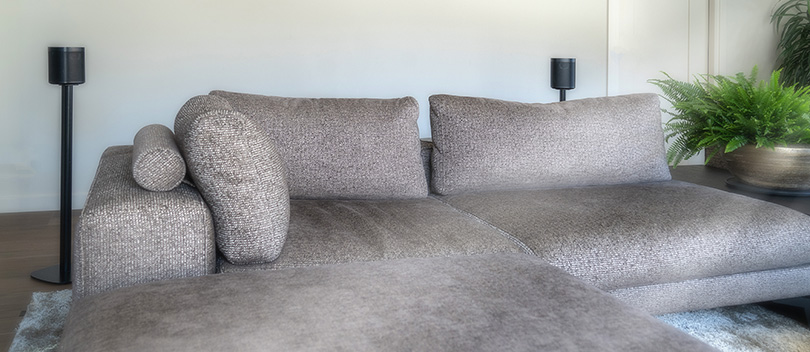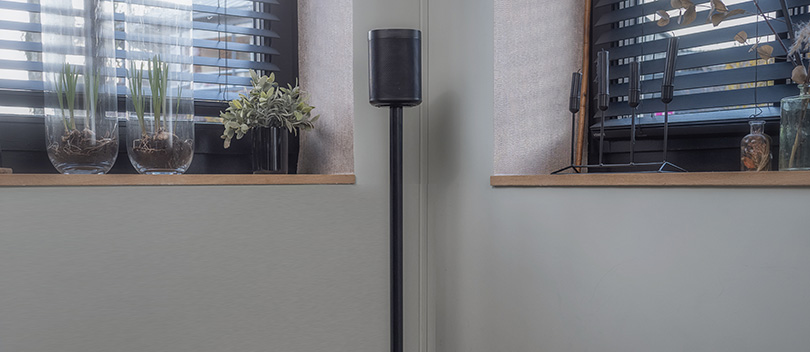
The arrangement of speakers largely determines how you experience sound. If speakers are not placed correctly, much of the sound quality can be lost. In this blog, we will even discuss in detail how best to place the speakers in your living room to get everything out of your speakers. After all, you bought your speakers for a reason, right?
The importance of the right speaker setup
Unfortunately, many people often overlook the potential of their audio equipment by placing speakers in random places in the living room. The result? A sound experience that is far from optimal, with subtle details lost and the full potential of your equipment left untapped. The ideal placement of speakers in a living room can vary depending on several factors, including the size and shape of the room, the type of speakers you use, and your personal listening preferences.
This is how to place your speakers the right way
What is the ideal speaker placement in your living room? What should you take into account? The sound coming out of your speakers consists of vibrations moving through the air. Where you place the speakers and what materials are present in the room affect how you hear the sound. This is why the perfect setup is not the same for everyone.
The point of a good music system is to let you sit back and enjoy great sound - without having to think about the technology behind it. Still, it is then important to stick to the right placement. Here's how to do it:
Speaker distance and listening distance
.Try to position the speakers so that they are about the same distance apart as the distance from the listening position to the speakers. This helps create symmetrical sound reproduction. For example, if you are sitting 2 metres from the speakers, place them about 2 metres apart as well. Often, people also speak of an equilateral triangle. An equilateral triangle means that the distance between the left and right speakers is equal to the distance of each from your listening position.
The ideal listening distance depends on personal preferences and the size of the room. In general, you should place your listening position in the centre of the room or at about a third of the length of the room if possible. Experiment with different distances to determine what sounds best for you.
The rotation angle of the speakers
Most of the time, it is a good idea to rotate the speakers slightly inwards so that they are aimed directly at your listening position. However, it is essential to ensure that both speakers have the same rotation angle. For example, if the left speaker is turned 30 degrees inwards from the seating position, the other speaker should also be set to 30 degrees. It is important not to go too far in turning the speakers in, as this can harm the sound quality. You may have to experiment a little to find out which angle of rotation produces the best sound for your specific situation, but as a general guideline, an angle of around 60 degrees is often recommended.
Height of speakers
Adjusting the height of the speakers is also important to ensure accurate sound reproduction. If the speakers are placed too high or too low, this can lead to a loss of detail in the sound and a less enjoyable listening experience. To really aim the speakers at your ears, it is also important to hang or place them at the right height. The rule is: always at 'ear height'. If this means putting your speakers on a shelf, for instance, you should definitely do that. It is best to put some foam rubber under your speaker to prevent sound vibrations from becoming audible. This tip is also useful if you want to put speakers on your desk.
Distance from walls
A speaker stand sounds best if it is not positioned too close to a wall or in a corner. As a general guideline, try to place speakers at least 30 centimetres to a metre away from walls. This helps reduce unwanted reflections from the walls and creates a more balanced sound. Keep in mind that the ideal distance from the walls can vary depending on the acoustics of your room. Again, experiment with speaker placement to determine what sounds best for your particular environment.
If you're still not satisfied, perhaps you should tackle your décor. Change the room. The listening position is just as important as the speaker position, and the elements and surfaces in the room also play a big role in how your room sounds. For example, make sure there is enough room for absorption and diffusion of the sound by placing furniture, curtains and a carpet. When doing so, make sure there are no obstacles between the speakers and the listening area. This disrupts the stereo effect.

Every room is different!
When setting up speakers, there is one golden rule you should always keep in mind: "Every room is different!" The living room in particular is a special room and usually not optimised for the highest sound quality. Often, the living room is the biggest room with the most volume, which should be filled with sound first. Moreover, there are numerous pieces of furniture, reflective surfaces and other factors that extinguish or amplify vibrations. In fact, in living rooms you often see a mix of different materials, such as leather or fabric, but also parquet or glass, for example.
This makes it quite difficult to make general statements about the perfect placement of speakers. Achieving the best result, tailored to your personal preference, often requires some fine-tuning. Only by experimenting will you know what works best for you.
Tips for ideal placement in a row
So, the ideal speaker placement in the living room can be quite a chore. Sometimes there is not enough space and, of course, the room has to remain livable. However, if you stick to these 5 tips, you will create a situation where the sound can reach its full potential. Have fun listening!
- Set speakers at ear level
- Avoid placing the speakers too close to walls or in corners
- Make sure the speakers are properly positioned relative to the listening position and placed at the correct rotation angle
- Minimise vibration disturbances
- Remove disturbances
